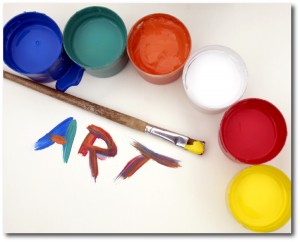Types of paint
 Some seniors who take up painting like to start with watercolors—which most of us remember using as children. Watercolor paints are inexpensive and easy to use, though not at all easy to master. Watercolors are applied with a gentle touch to paper, and, as explained on the children’s website kidzworld.com, are “somewhat difficult to use because the paint changes form as it dries.”
Some seniors who take up painting like to start with watercolors—which most of us remember using as children. Watercolor paints are inexpensive and easy to use, though not at all easy to master. Watercolors are applied with a gentle touch to paper, and, as explained on the children’s website kidzworld.com, are “somewhat difficult to use because the paint changes form as it dries.”
Acrylics are another type of paint popular with beginners. According to kidzworld.com, acrylics “are easy to work with because they’re thicker than watercolor paints. Because they are thick, they are easy to blend with other colors and easy to control when painting them on a canvas. Acrylics dry quickly and turn into plastic, so if you make a mistake it is easy to wait a few minutes for it to dry and then paint right overtop of the mistake.”
Oils are the thickest paint and, according to kidzworld.com, the “easiest to control.” Oil paints are more expensive than watercolors and acrylics, and can be messy and difficult to clean up. According to kidzworld.com, “They take days to dry so you can work with the paint for hours to get the images you want. Once applied to a canvas, you can work in other colors easily, change the form and textures, all over long periods of time. If you make a mistake, you can scrape of an entire layer of paint without damaging the layers underneath.”
You may want to try your hand at:
- Portraits
Would you like to paint images of family members or friends? Famous faces? Animals? Portrait-painting isn’t simply a matter of trying to produce what a camera might capture. Portrait painters have a great deal of latitude and discretion when it comes to “capturing” their subjects. For example, they often have to decide what characteristics of the subject ought to be highlighted or in what way an aspect of the subject’s personality should be presented.
- Landscapes
Are you up to the challenge of capturing the great outdoors on paper or canvas? Do you want to take your new hobby out on the road … to the seaside, a mountainside, or a national park? Would you like to memorialize that fluffy cloud that looks like a sheep, or the color of a sky that can’t quite be described in words? If so, landscapes may just be your niche.
- Still life
Would you like to make inanimate objects come to life? How appetizing can you make that bowl of fruit look? Can you make that porch swing appear to move back and forth or that violin seem to play a melody? Are you capturing those shadows or getting those shapes just right? And that plate of food you’re putting on canvas … can you make it appetizing enough to cause a viewer to drool?
- Abstract
A lot of people think abstract-painting is for those who can’t really paint. They figure that since an abstract painting doesn’t have to look “real,” anything goes. In one sense they’re right, because anything does go when it comes to abstract painting. You can try to project any emotion you want through your choice of colors and shapes, and in terms of realism you can stay as close as you want to the original or stray as far as you dare. But don’t expect any shortcuts if you’re planning to specialize in abstract art. Abstract painters definitely need as solid a foundation and set of skills as painters who specialize in any other style.
Whatever you choose to put into painting—or hope to get out of it—painting offers a variety of physical and emotional benefits that are hard to deny. Many people are aware of how creative expression can stimulate activity and responses in parts of the brain that too often go unused. Painting is also widely regarded as one of the best stress relievers around … and almost everyone nowadays knows about the importance of stress management in staying clear of a variety of serious physical and mental ailments.
Never too late
One of the most beloved artists in American history didn’t take up painting until she was in her 70s. She sold some paintings during her early years as a painter, and by the time she was 80 her work was widely on display. Before passing away at 101, she produced well over 1,000 paintings and was widely regarded as a national treasure.
Grandma Moses achieved all this without significant training. Her simple scenes struck a chord, her work was among the most reproduced of its age, and today—over half a century after her death—she remains one of the most beloved American artists …
And she started in her 70s, with arthritic hands.
Beat stress by trying your hand at painting—and by contacting MedicareMall to learn more about how Medicare supplement insurance can help protect you against the gaps in Original Medicare coverage.
What style of painting suits you? Leave a comment below!
Painting for Seniors—Why Not?© 2013 MedicareMall.com

Been painting off and on for years and work in watercolor. Also do stained paper collage. Painting requires concentration, you can’t worry about much else and the time flies by.